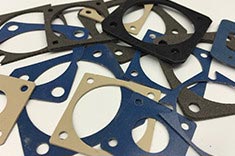EMI Shielding Products
- Custom Gasket Fabrication
- Connector Gaskets
- Bonded O Ring
- Custom Gaskets
- Conduct-O-Knit Knitted Wire Mesh
- Conduct-O-Seal Combo Gasket
- Conduct-O-Elastomer
- Conduct-O-Seal Oriented Wire in Silicone Gasket Material
- Conduct-O-Mesh Tape
- Conduct-O-Foam
- Conduct-O-Bond
- Optical Filters For Electronic Displays
- Shielded Vent Panels
- ESC Board Level Shielding
- 300 Series
Understanding RFI Coupling Mechanism: How EMI Shielding Helps
 The emerging landscape of 5G electronics presents a unique set of challenges and opportunities for EMI shielding. It's no longer about merely incorporating a shield but about considering factors such as shielding materials, shield design, and seal quality that collectively influence its efficacy. Let's delve into these elements to decode the complex world of EMI shielding for 5G electronics.
The emerging landscape of 5G electronics presents a unique set of challenges and opportunities for EMI shielding. It's no longer about merely incorporating a shield but about considering factors such as shielding materials, shield design, and seal quality that collectively influence its efficacy. Let's delve into these elements to decode the complex world of EMI shielding for 5G electronics.
Shielding Materials: The Building Blocks of Effective EMI Shields
The shielding material is the heart of the EMI shield. The choice of material can have profound implications on the shield's effectiveness in a 5G environment.
The Role of Shielding Materials
The right shielding material is the cornerstone of an effective EMI shield, forming the first line of defense. Shielding materials determine how much interference can be deflected, absorbed, or passed through.
Metals in Shielding: Copper, Nickel, and Aluminum
Due to their high conductivity, copper, nickel, and aluminum have found favor in EMI shielding. But each of these metals brings something unique to the table in the context of 5G electronics, from copper's excellent electrical and thermal conductivity to aluminum's lightweight nature.
Non-Metal Materials: Emerging Trends
There has been an increased interest in non-metal materials for EMI shielding. From conductive polymers to composite materials, the push towards lighter, flexible, and cost-effective alternatives is reshaping the EMI shielding landscape.
Shield Design: The Science and Art Behind EMI Shields
The design of the EMI shield can make or break its effectiveness. From understanding the device's operating environment to designing for manufacturability, a lot is riding on the design.
Designing for the Device's Operating Environment
The shield design should consider the specific EMI threats in the device's operating environment. Each aspect requires careful attention, from the range of frequencies to the level of interference.
Designing for Manufacturability
Designing an EMI shield isn't just about performance; it's also about manufacturability. Material availability, ease of fabrication, and cost can significantly influence the design process.
The Future of Shield Design: Integration and Miniaturization
The future of EMI shield design lies in integration and miniaturization. As electronic devices shrink and integrate more functions, shield designs must adapt to meet these evolving needs.
Seal Quality: The Unsung Hero of EMI Shielding
Seal quality often flies under the radar, but it's critical to EMI shielding. It ensures the integrity of the shield, preventing EMI leakage.
Why is Seal Quality Important?
A high-quality seal ensures that EMI doesn't slip through the cracks, providing a comprehensive shielding solution. Every detail counts, from the choice of sealing material to the application method.
Choosing the Right Seal
Different seals serve different purposes. From conductive gaskets for high-frequency applications to non-conductive seals for low-frequency scenarios, the choice of seal can impact shielding effectiveness.
The Future of Sealing: Advanced Materials and Techniques
The quest for superior seal quality has sparked interest in advanced materials and techniques. From conductive elastomers to form-in-place gaskets, the future of sealing looks promising.
EMI shielding for 5G electronics is a complex, multifaceted issue that requires a holistic approach. By paying close attention to shielding materials, shield design, and seal quality, manufacturers can craft EMI shields that meet today's needs and are ready for tomorrow's challenges.



